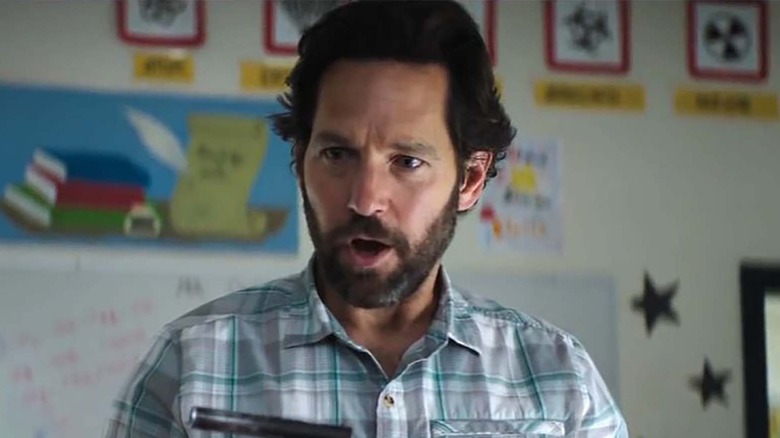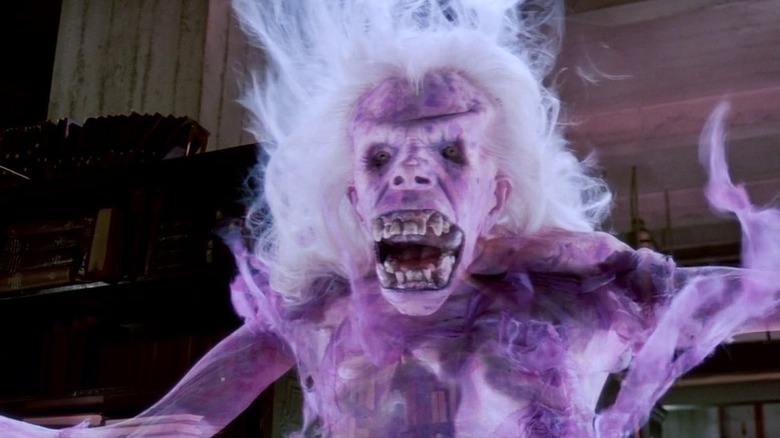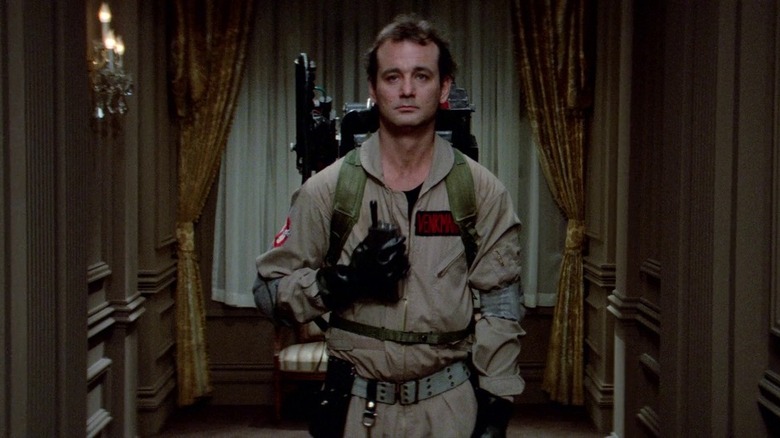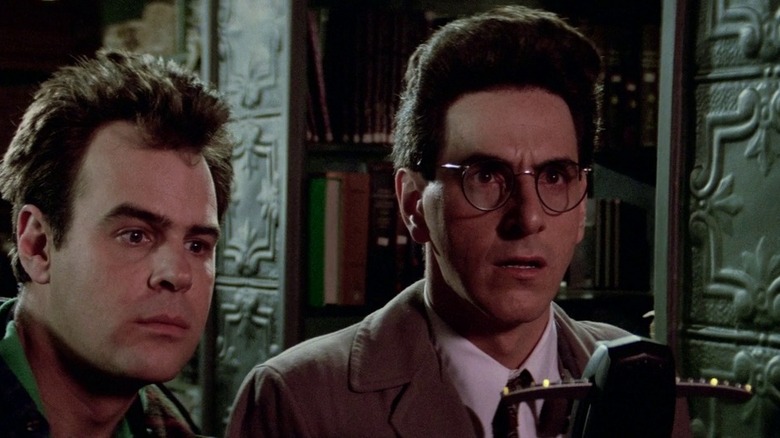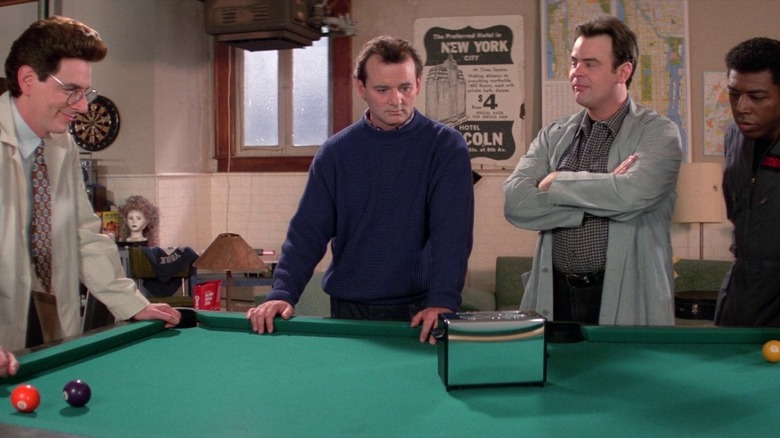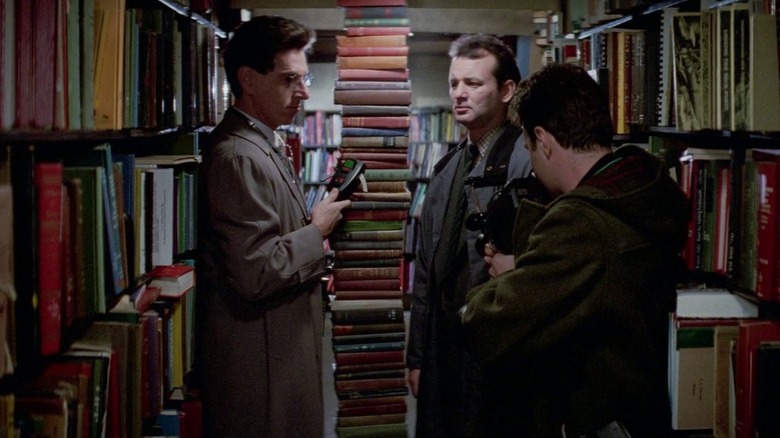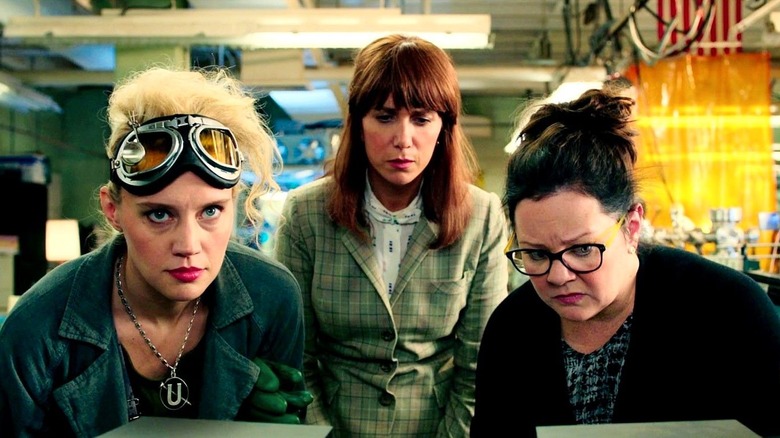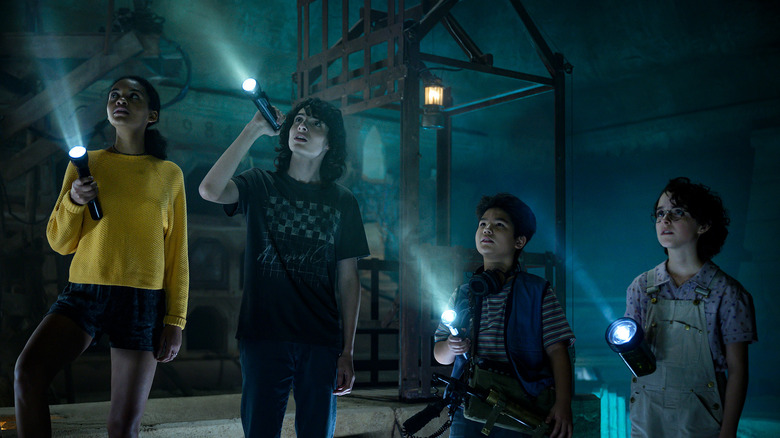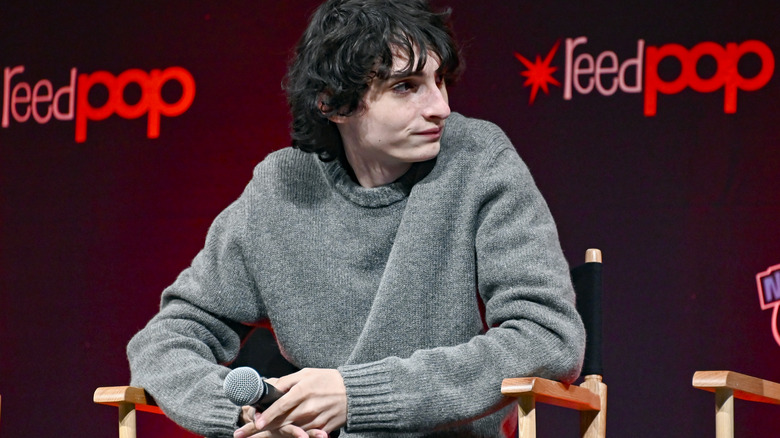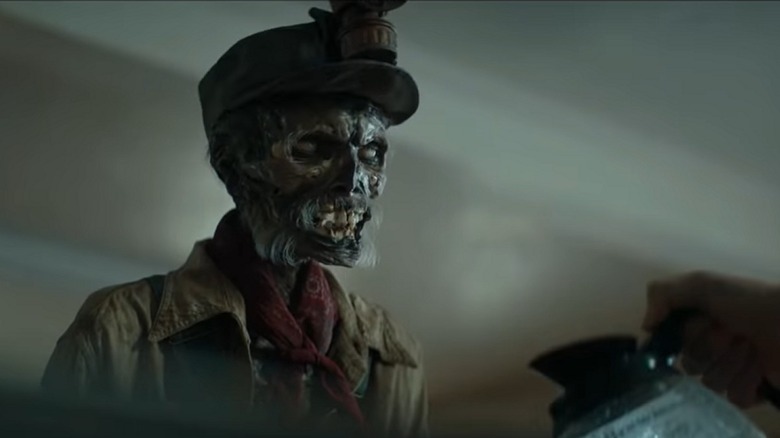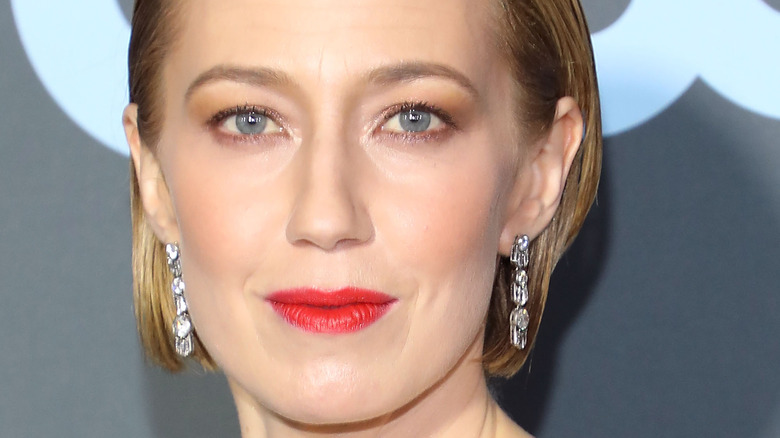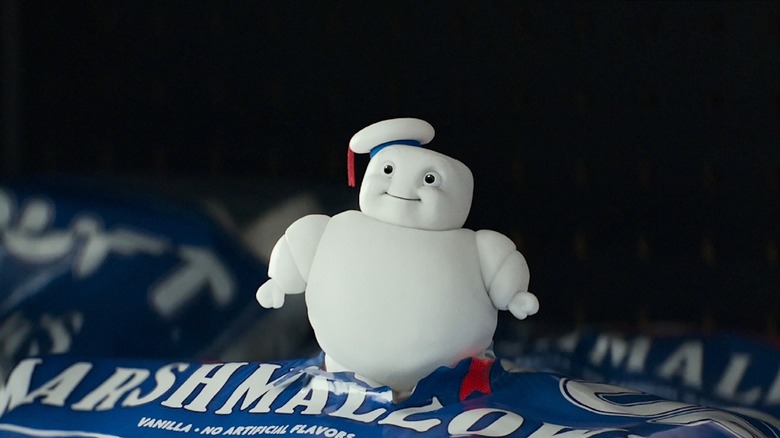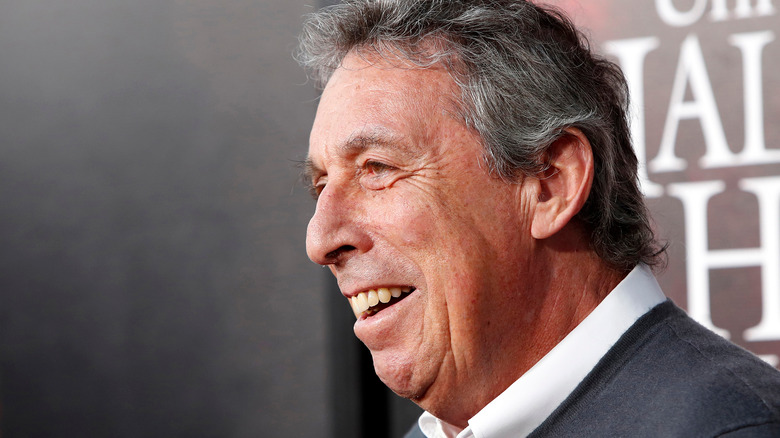The Untold Truth Of Ghostbusters: Afterlife
Though the original film is one of the most iconic comedies in history, the "Ghostbusters" franchise hasn't been as fruitful as one might imagine. True, "The Real Ghostbusters" cartoon was a smash hit in the 1980s, and "Ghostbusters 2" was a moneymaker at the box office. However, getting another "Ghostbusters" movie off the ground after that 1989 follow-up has proven to be a consistently challenging effort. Waiting for the stars to align so that a direct sequel to the original two "Ghostbusters" can finally haunt movie theaters, that's been a difficult prospect. However, years of waiting resulted in the 2021 Jason Reitman directorial effort "Ghostbusters: Afterlife," which handed the proton packs off to a new adolescent generation while being firmly rooted in the continuity of the original beloved motion pictures.
Though meant to be a piece of fast-moving escapist cinema, the road to "Ghostbusters: Afterlife" was one fraught with problems. The untold truth of this project is packed with unmade attempts to turn a third "Ghostbusters" movie into a reality, including one potential route where it looked like one of the original cast members might get recast. However, this untold truth also reflects the passion that went into making "Ghostbusters: Afterlife" and at least that part of the film's background is bound to make diehard fans of this franchise feel good.
An early attempt at a third Ghostbusters movie
Long before "Ghostbusters: Afterlife" or even the 2016 "Ghostbusters" remake, the creative team behind these spooky comedies had a slew of different ideas for a follow-up to "Ghostbusters 2." One concept that got far enough along to spawn an entire screenplay was "Ghostbusters: Hellbent," penned in 1999. This project was defined by having the titular team square off against not just Slimer, but Satan, hence why the title emphasizes the word "Hell."
In a rundown on the script, IGN noted that the thrust of the plot concerned Hell becoming overcrowded and some of those tormented souls spilling over into the mortal world. Meanwhile, Bill Murray's Peter Venkman had a tiny role in the storyline, apparently to accommodate Bill Murray's disinterest in the project. This also helped make room for a new team of Ghostbusters, who headlined the movie while fighting an Earth-dwelling businessman who is actually the Dark Lord of the Underworld in disguise. An earlier piece from IGN featured a quote from Dan Aykroyd (who penned the "Hellbent" screenplay) that revealed this iteration of the project never got off the ground due to budgetary issues.
Bill Murray almost got recast
It's impossible to imagine the original "Ghostbusters" films without Bill Murray playing the role of Peter Venkman. However, due to Murray's uncertainty over appearing in another "Ghostbusters" project, there have been various contingency plans over the years over what to do with a third "Ghostbusters" movie if Murray didn't agree to reprise his role. At one point, these ambitions included just having another actor slide in and take on the iconic role of Peter Venkman.
Speaking to Empire, as reported by The A.V. Club, Dan Aykroyd said in 2012 that the then-current script for "Ghostbusters 3" did involve Venkman and they all wanted Murray to come back to play the part once again. However, if Murray wasn't interested, Aykroyd openly expressed plans to have another performer take on the role, with the constant recasting of the character Jack Ryan being his guiding star in this process. While it's true certain movie characters can survive recasting, Venkman is so defined by Murray's screen persona that it's hard to imagine that audiences would've accepted someone else in the role. Luckily, this iteration of "Ghostbusters 3" fizzled out, and with it, so did the idea of recasting Bill Murray in the "Ghostbusters" universe.
The impact of losing Harold Ramis
The original "Ghostbusters" movies are not one-man shows. They benefit from an ensemble cast that extends beyond the main quartet to memorable supporting turns from Sigourney Weaver and Rick Moranis. Among the performers that leave such a massive impression in those titles is Harold Ramis as Egon Spengler. The most scientific minded in a group of scientists, Ramis brought believable intellectual heft but also expert comic timing to his work fighting ghouls from beyond the mortal realm.
It's hard to imagine the world of "Ghostbusters" without Ramis' Spengler, but that's just what fans would have to grapple with beginning in February 2014, when Ramis passed away at the age of 69. In the wake of his passing, the then-current screenplay for "Ghostbusters 3" had to be reworked to account for his absence. Years later, the passing of Spengler would become a crucial part of "Ghostbusters: Afterlife." Though the character has also passed away in-universe, his daughter and grandchildren are now the focus of the plot. Meanwhile, a prologue to "Afterlife" chronicled Spengler's final moments while fighting some supernatural force. Through his presence in "Afterlife," it's apparent Ramis will never stop influencing the world of "Ghostbusters."
The departure of director Ivan Reitman
For all the decades that "Ghostbusters 3" was in development, it was long presumed that the director of the first two installments, Ivan Reitman, would be returning along with the main cast members. In January 2010, Reitman confirmed he was returning behind the camera to helm the next entry in this franchise and expressed excitement over the possibilities of the project. He would continue to be attached to directorial duties on a prospective third "Ghostbusters" movie as late as February 2014.
However, plans suddenly changed in March 2014, when Reitman stepped down from the position and agreed to let a new filmmaker take on the task of helming a "Ghostbusters" project. This iteration of the third "Ghostbusters" movie would eventually transform into the 2016 remake and going from doing a sequel to a remake apparently informed Reitman's departure. Whereas earlier iterations of the production were a conventional follow-up to "Ghostbusters 2," later drafts of "Ghostbusters 3" shifted it in the direction of a reboot. Now that this would be a whole new take of the "Ghostbusters" mythos, it was decided that a similarly fresh take when it came to filmmaking would also be implemented. Eventually, Paul Feig would take on the prospect of tackling this new "Ghostbusters" project, marking the first time a "Ghostbusters" film wasn't helmed by Ivan Reitman. Of course, the Reitman family would, eventually, return to directing "Ghostbusters" films years down the road thanks to Jason Reitman helming "Ghostbusters: Afterlife."
The sudden announcement of Ghostbusters: Afterlife
At the start of 2019, all had been quiet on the "Ghostbusters" front. The 2016 film failed to turn a profit and a proposed sequel to the project had been scuttled. In 2017, furthers news on an animated "Ghostbusters" movie told from the viewpoint of a ghost emerged, but that proposed project was otherwise engaged in radio silence. But suddenly, just like a ghost popping out from a drawer in a library, the "Ghostbusters" franchise came roaring back to life with little prior warning.
In January 2019, Entertainment Weekly broke the big news that a new "Ghostbusters" film set in the continuity of the original film was on the way, with Jason Reitman writing and directing the project (Gil Kenan also penned the script). Considering there hadn't even been whispers of Sony pursuing a new take on this property in the months beforehand, it was shocking to consider that this report confirmed that a new "Ghostbusters" wasn't just brewing but would start filming in a few months. At the time of its announcement, Reitman promised endearing new characters to accompany franchise staples that hadn't been seen on the silver screen in years. Though the franchise had been in mothballs for a few years, the announcement of "Ghostbusters: Afterlife" revved up this saga's engine.
What Ghostbusters: Afterlife owes to the 2016 Ghostbusters
The 2016 take on "Ghostbusters" opted to set its story in a whole new universe detached from the original "Ghostbusters" movies. This allowed its lead characters to develop the idea of ghostbusting all on their own rather than just lean on what dudes had done in the past. Though "Ghostbusters: Afterlife" was bringing the saga back to the original continuity of the series, director Jason Reitman still said this installment owed a debt of gratitude to Paul Feig's vision of the franchise.
Specifically, Reitman explained to CinemaBlend that "Afterlife" owed its existence to Feig's "Ghostbusters" because it proved that anybody from any background could be a Ghostbuster. With the occupation no longer being limited to the four leads of the original movies, Reitman could explore his own "Afterlife" storyline concerning a new generation of ghoul hunters picking up proton packs. He concluded these comments by proclaiming that Feig's interpretation of this universe would be influential on the franchise for years to come. Reitman would continue to make it clear in later interviews that Feig's take on this material was instrumental in making "Afterlife" possible by radically reshaping the idea of who could be a Ghostbuster. With these kinds of comments, Reitman made it apparent that the 2016 "Ghostbusters" had an impact on "Ghostbusters: Afterlife," even if they didn't occupy the same continuity.
Why Afterlife was taken out of the city
One subtle way "Ghostbusters: Afterlife" differentiates itself from its three predecessors is its backdrop. Prior "Ghostbusters" weren't just set in New York City, they used every inch and landmark of this domain to their maximum effect. The hustle and bustle of everyday life in the Big Apple was the perfect backdrop for similarly chaotic ghost mayhem. Meanwhile, "Ghostbusters: Afterlife" is set in a more laidback rural area, one populated by fields of corn, not streams of taxicabs caught in traffic.
While breaking down the movies first trailer for IGN, "Ghostbusters: Afterlife" director Jason Reitman revealed that the change in setting was a conscious one for this production. Setting "Afterlife" in America's West offered plenty of advantages for this story. For one thing, it allowed for the film to indulge in a brand-new visual palette that helped to immediately distinguish the sequel from other "Ghostbusters" movies. Reitman also felt going for this setting provided an effective connection to the central theme of "Afterlife" concerning going back to one's roots. Though this kind of setting hasn't been the norm for "Ghostbusters" movies, abandoning New York City was a conscious and carefully thought out decision for "Ghostbusters: Afterlife."
Finn Wolfhard's initial uncertainty over auditioning for Ghostbusters
Even beyond his work in the TV show "Stranger Things," Finn Wolfhard has already cultivated a solid filmography at a young age. Not only did he appear in a prominent capacity in both of the "It" movies, but he also had a role in the 2019 drama "The Goldfinch" and provided voice work for "The Addams Family" and the "Carmen Sandiego" Netflix cartoon. Given all these achievements, you'd presume Wolfhard has a sense of confidence heading into any audition. When it came to "Ghostbusters: Afterlife," though, Wolfhard initially felt there was no reason to even throw his hat into the ring for the project.
While talking to The Hollywood Reporter, Wolfhard explained that he was convinced that "Ghostbusters: Afterlife" director Jason Reitman wouldn't give his audition tape the time of day since Wolfhard had already dressed up in a "Ghostbusters" costume on "Stranger Things." However, despite seemingly throwing away his shot on a "Ghostbusters" project, all hope was not lost for Wolfhard. Once the filmmaker watched this audition tape, Reitman ended up gravitating towards Wolfhard's approach to his "Afterlife" character. Thus, Wolfhard got the best of both worlds by getting to dress up as a "Ghostbuster" in "Stranger Things" and then inhabiting the actual franchise. Chalk it up as yet another notable achievement in Wolfhard's career.
Reitman wanted to make the ghosts genuinely scary
The original "Ghostbusters" movies are unquestionably comedies and the ghosts contribute their fair share to those gags. Most notably, who can forget the specter in the first "Ghostbusters" that has a particularly intimate moment with Dan Aykroyd? But they were also capable of being genuinely scary, as seen by beasts like the Terror Dogs. Committing to these creatures being capable of providing actual frights helped make the threats fought by the titular characters of "Ghostbusters" tangible rather than just a hollow source of gags.
For "Ghostbusters: Afterlife," Jason Reitman was determined to maintain that level of scariness, particularly with the new otherworldly creatures seen in the new film. Talking to IGN, Reitman noted that familiar ghosts in the franchise, like Slimer, had been around for so long in pop culture that they'd cultivated a reputation for being cuddly, not unnerving. Considering that, he sought to give the adolescent leads of "Afterlife" genuinely creepy ghosts to square off against. This decision ensured there'd be an even greater sense of connectivity across these "Ghostbusters" installments and, perhaps most importantly, that a new generation of kid moviegoers would be spooked and laughing in equal measure.
Why Carrie Coon joined Ghostbusters: Afterlife
Though she provided motion-capture and voice work for one of the children of Thanos in "Avengers: Infinity War," Carrie Coon has otherwise avoided big-budget genre fare in her film acting career. Instead, Coon has opted for challenging adult dramas like "The Nest" or "Widows." Considering that career trajectory, it can be puzzling to consider why Coon would then choose to appear in "Ghostbusters: Afterlife" as the mother of the film's adolescent protagonists.
Talking to Collider, Coon explained she had hesitancy about the role initially, since other actors, like Dee Wallace, that had portrayed mothers in kid-friendly genre fare had ended up getting pigeonholed into those roles. However, Coon ended up impressed by how writer/director Jason Reitman's screenplay for "Afterlife" addressed those concerns by giving her character active agency and a discernible personality. Rather than being a passive maternal figure to the adolescent protagonists of "Afterlife," Coon would have a much larger role to play here. She ends up having such a significant hand in warding off evil spirits that Coon declared "I'm a Ghostbuster, basically!" while also expressing appreciation for the number of comedic moments she was handed. Once she was certain she wouldn't just be sitting on the sidelines in "Ghostbusters: Afterlife," Coon had no problem embracing a different project compared to her past works like "Gone Girl."
How those mini Stay Puft Marshmallow Men were realized
For "Ghostbusters: Afterlife," the iconic Stay-Puft Marshmallow Man returns, but in a way that fits into a modern pop culture landscape defined by Baby Yoda and Baby Groot. Now, this beast is manifested as an army of tiny Stay Puft Marshmallow Men who cause all kinds of chaos in a Wal-Mart aisle, including burning one of their brethren to a crisp in the name of making S'mores. Watching this scene, one can easily the merchandising potential in such characters, but one also wonders what the process was like reimagining the original character into this cutesy form.
"Ghostbusters: Afterlife" visual-effects producer Kerry Joseph told Entertainment Weekly that these were the most difficult characters to realize from a visual effects standpoint. This was due to how much rambunctious activity these ghosts are engaging in during their screentime, they're always on the move and never lying down. Joseph also noted that no drastic tweaks were made to the original Stay-Puft Marshmallow man while Jason Reitman instructed the visual effects team to model their behavior after toddlers. Through these details, a new vision of a famous "Ghostbusters" figure was born, much to the delight of toy marketers across the world.
How Ivan Reitman responded to Ghostbusters: Afterlife
Ivan Reitman has watched "Ghostbusters 3" gestate for so long that it's understandable if he truly believed it would never get made. Decades of development, not to mention countless starts and stops, made it seem like this feature would prove to be an impossibility. But "Ghostbusters: Afterlife" finally brought the idea of a direct follow-up to "Ghostbusters 2" to life, a monumental achievement that, apparently, left Reitman profoundly moved when he got to see the final product. Speaking to Empire, Jason Reitman recalled how Ivan Reitman, his father, journeyed out to the Sony lot to view a screening of the finished movie. It was a momentous occasion for several reasons, including the fact that the elder Reitman hadn't left his home very often since the COVID-19 pandemic began.
One must imagine the tension in the air before the screening of such a highly anticipated movie was high. This project had been gestating for decades now, could it possibly live up to all the hype? However, once the credits began to roll on "Ghostbusters: Afterlife," Jason Reitman said his dad began to cry before telling his son "I'm so proud to be your father." All those years of getting "Ghostbusters 3" off the ground must have been worth it for such an emotionally cathartic moment of father-and-son bonding.
